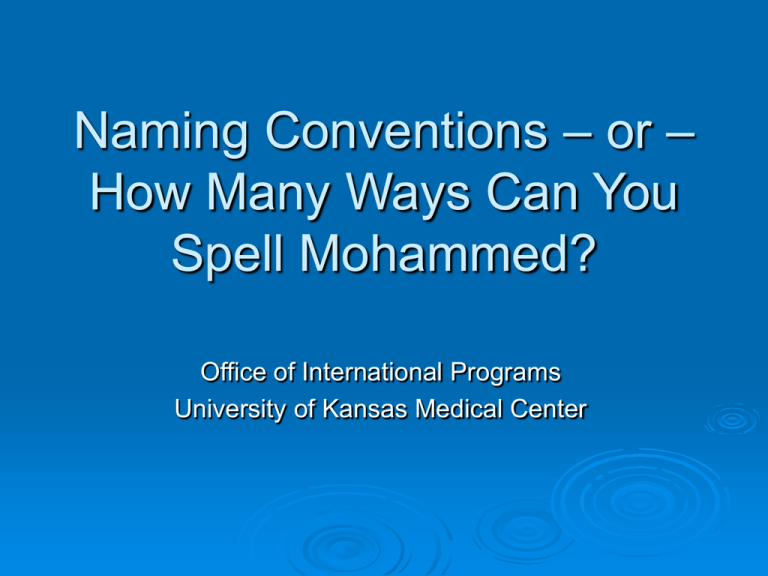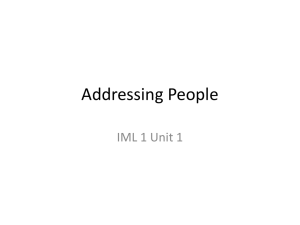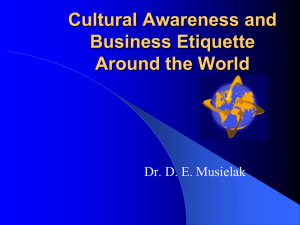naming_conventions_2007
advertisement

Naming Conventions – or – How Many Ways Can You Spell Mohammed? Office of International Programs University of Kansas Medical Center Who We Are Julia Shaw, Associate Director, International Programs University of Kansas Medical Center Kerry Allen, Sr Coordinator Academic English and Cultural Studies University of Kansas Medical Center What is in a Name? Common to all mankind Self Possible associations include: • • • • • • • • • • Gender Family Social status Generation Spirituality or religion Region or area Heritage / Race Wealth Occupation Caste What Do These Names Say to You? Bobbi Sue Taylor Floyd and Iris Miller Reggie White Olga Johansen Salvatore “Sal” Falco David Levi Solomon Basil Thibodeau Tiffany Hart Miguel Garcia Mohammed Shirazi How Many Ways Can You Spell Mohammed? Transcription & Transliteration The “translation” from one writing form to another. Transcription is a more phonetic interpretation Transliteration represents the letters exactly Why transcription instead of transliteration? Some English vowel sounds don’t exist in the other language and vice-versa Some English consonant sounds don’t exist in the other language and vice-versa Some languages are not written with letters Issues Related to Transliteration & Transcription Lack of consistent rules for some languages or varying sets of rules Country variations in choice of rules Country/regional variations in pronunciation Same name may be transcribed differently even within the same family More confusing when common or religious names cross over several countries with different scripts (Islam - Mohammed) Arabic Transcription There are three letters with vowel sounds – a, i, u. Short vowel sounds are not written. The letter “hamza” is a glottal stop, it has no sound and is not pronounced Consonant sounds not found in English include “kh” and “q or gh” Arabic is written from right to left Use of Arabic Script Use of Arabic Script Middle East and Central Asia South Asia Urdu, Punjabi, Sindhi, Kashmiri and Balochi in Pakistan Urdu and Kashmiri in India Southeast Asia Kurdish and Turkmen in Iraq Farsi (Persian) and Baluchi in Iran Dari, Pashto and Uzbek in Afghanistan Uyghur, Kazakh and Kyrgyz in northwest China Malay in Burnei Malaysia, Indonesia, southern Thailand, Singapore and the Phillipines for religious purposes Africa Bedawi or Beja in Sudan Hausa in Nigeria Tamazight and other Berber languages محمد M-H-M-D Vowels and their pronunciation depend on region D and T interchangeable and depend on region Middle “M” sometimes repeated when transcribed How do you spell ……? Mehmed Mahomet Mahmed Mahmud Muhammed Mohammed Mohammet Gadhafi Common spellings of Libyan leader Moammar Gadhafi's name: Qaddafi Qatafi Quathafi Kadafi Kaddafi Khadaffi Gadhafi Gaddafi Ghadafy All names listed above with al-……….. Cyrillic Script The Cyrillic alphabet is actually a family of alphabets, subsets of which are used principally in Slavic, but also other, languages. Not all letters are used in every language this is written with it. Common spelling variations in names occur with the sounds/letters: • Y–J–I • Gh – G – H • Zh - J Cyrillic to Latin Alphabet After the disintegration of the Soviet Union in 1991 some countries transitioned to the Latin alphabet Uzbekistan Azerbajian Turkmenistan In other countries the Cyrillic alphabet is also written in the Latin alphabet Serbia Croatia Bulgaria Belarus Bosnia Use of Cyrillic Script Chinese Languages Transcription The major Chinese languages (Mandarin & Cantonese) are based on images and syllables, known as monosyllabic logograms, rather than individual letters There is no Chinese alphabet Pinyin style is the type of transcription used in mainland China Wade-Giles is the type of transcription used in Hong Kong, Taiwan and Singapore. Uses hyphens between syllables • Wang Mao-hsin or Liu Mei-lai Transliteration of Chinese Names Names of the World’s Peoples: A Comprehensive Dictionary of Names in Roman –Chinese Complied by the Proper Names and Translation Service of the Xinhua New Agency Based on Mandarin Provides standardization of names Japanese Transcription The Japanese language is expressed through characters and uses more than one writing system Kanji – Chinese characters Hiragana – Japanese writing form used when Kanji characters don’t exist; curvy letters Katakana – Used to write “foreign” names and words and names of other countries; sharper more square like-letters 私はトムを知っている Any name may have several written forms A name written in kanji may have more than one common pronunciation. For example, Nakata and Nakada have the same kanji -中田 小野 洋子 Ono Yōko may be written in English as Yooko, Youko or Yoko. Her name is pronounced “Yoko” not “Yooko” Naming Conventions Definitions Given name Second name American “middle name” Surname Personal name American “first name” Name a person calls oneself Christian name American “last name” Family name Name typically associated with the family but this can vary by country In this presentation we provide examples of the naming practice by using American names US and Europe Naming Susan Given name Second or middle names more common in US Women typically take husband’s family name upon marriage Elizabeth Second name Jones Surname Some women drop maiden family name and replace with husband’s family name Some women drop second name, and use the maiden name as the second name ( Hilary Rodham Clinton) Some women choose to keep their maiden name or hyphenate the maiden and married surnames In Eastern Europe and Russia: Women take husband’s surname, however it carries a feminine ending • Example: Trotsky becomes Trotskya, Davidov becomes Davidova Names ending in –ski or –owicz are typically Polish Names ending in –sky are Russian, Ukrainian, Czech or Slovak Hispanic Naming Susan Given name second name Hispanic names consist of both the paternal and maternal family names If you wanted to Americanize the name it would be Elizabeth Jones father’s family name Brown mother’s family name Susan Elizabeth Jones What may appear as a given name and a second name, may actually be the given name. Example: Luis Miguel, Juan Carlos, Luz Maria Nicknames are very common in Mexican culture. Some people are known to others only by their nicknames. Hispanic Naming (cont’d) Susan Given name second name father’s family name mother’s family name Women traditionally retain their names after marriage. In some areas the women might add her husband’s family name to her own. There are regional variations Example: Susan marries Juan Garcia Chavez. She may change her name to: • Susan Elizabeth Jones Brown de Garcia • Susan Elizabeth Jones de Garcia • Susan Elizabeth Jones Sra. de Garcia Children’s names will differ from both the parents. Elizabeth Jones Brown Susan Jones Brown and Juan Garcia Chavez’s children might be named: • Jose Garcia Jones • Marcia Garcia Jones Brazil & Portugal Naming Susan Given name second name Elizabeth Brown mother’s family name Like de Jones father’s family name Hispanic names, consists of both the paternal and maternal family names, however in a different order A preposition of: de, del or de la is common prior to the father’s family name If you wanted to Americanize the name it would be Susan Elizabeth Jones Filipino Naming Susan Given name Hispanic influence in many names, but do not follow Hispanic naming conventions Second name is mother’s family name When a woman marries, father’s family name becomes middle name and husband’s family’s name becomes last name Susan Brown Jones marries Joe Smith. She drops the Brown and becomes Susan Jones Smith Brown mother’s family name Jones father’s family name East Asian Naming In many east Asian cultures the family name or surname is first in the naming order Japan China Korea Vietnam Laos Hmong Cambodia Vietnamese Naming Jones surname Vietnamese names are written in an order opposite of western names There are reportedly no more than 300 family names with the most common being Nguyen (pronounced similar to “win”). Other family names include: Tran, Le, Vu, Vo, Huynh, Pham, Ngo, Troung, Doan, Trinh, Dang, Bui, Lam Many Vietnamese names are related to Chinese clans or family names The second name identifies the gender of an individual. The second name may remain the same for all male members of the family Common middle names for men are Van, Huu, Duc, Dinh, Xuan, Ngoc, Quang, Cong Women retain their names after marriage Elizabeth second name Susan given name Chinese Naming Jones Susan surname given name The order is “reversed” with surname first then the given name Li, Wang, and Zhang are the most common Chinese family names. Most family names are only one syllable long A family’s hopes are often reflected in a child’s given name. Zhifu (getting rich), Xinghau (rejuvenate China) Men’s names typically imply honor to ancestry, militaristic bearing or virility, such as Gang (steel) Jinsong (sturdy pine), Ren Youcheng (accomplishment) Women’s names include words related to beauty, jewelry, flowers or birds, such as Hua (flower), Yan (beautiful), Mei (enchanting) Women retain their names after marriage Korean Naming Park surname Korean names consist of a surname followed by a given name. Only about 250 Korean family names are in use. Almost 50% of Koreans have the family name of Kim, Park or Lee Lee and Yi are the same name in written Korean The surname is usually one syllable and the given name is usually a two-part hyphenated name Koreans have no middle names. You may see two names written together or hyphenated and these represent the given name Women keep their names following marriage Susan-Elizabeth given name Japanese Naming Jones Susan surname given name In Japanese names, the surname is first and then the given name. There are no middle names Most names are written in Kanji with a variety of possible pronunciations Suzuki, Takahashi and Katō are common surnames. There are as many as 100,000 surnames in use in Japan and their usage varies by region. The Japanese government regulates names written in Kanji. Only Kanji which appear on the government list (about 2,230) may be used in given names The Japanese usually address someone by his or her surname followed by “–san” or often refer to someone by his or her title rather than name (sensei, sacho, etc.) Male given names often end in –ro (son) or –ta (great) or –ichi (first) Female given names often end in –ko (child) or –mi (beauty) Women do adopt the husband’s surname after marriage India Naming Indian names are based on a variety of systems and naming conventions, which vary greatly region by region Names are influenced by religion, caste and occupation as well as other cultural influences British Portuguese Caste names include: Nair, Reddy, Patel, Gandhi India Naming – Religious Influence Sikh names often use Singh as the surname or as a suffix to the surname; however, Singh is a clan name and, therefore, not used exclusively by Sikhs Jains often use the surname of Jain. Like Singh this is a surname used by other Indians as well Most Hindu names consist of a given name, possibly a second name, and a family based surname. The second name may be the father’s given name Indians of the Christian faith follow British naming conventions Indians of the Moslem faith follow conventions similar to Arabic naming conventions Southern India Naming Chicago Region or village Robert father’s given name ____ Paul given name In the southern states of India (Andhra Pradesh, Tamil Nadu, Karnataka, and Kerala), naming conventions are not consistent and vary considerably by region Typically there is no “family” name The names are often abbreviated, with the exception of the given name Example: C. R. Paul Women take the husband’s given name after marriage, and it replaces the father’s given name Women use initials also. However, before marriage they use the father’s initials with her given name. After marriage she uses her husband’s initials with her given name Arabic Naming Susan Given name Naming conventions vary region by region and by religion (Moslem, Jewish, Christian) The use of honorific, patronymic, and tribal names is common Surname Abu Karim Muhammad al-Jamil ibn Nidal ibn Abdulaziz al-Filastini Father of Karim, Muhammed, the beautiful, son of Nidal, son of Abdulaziz, the Palestinian. The use of titles is common– al Haji “Al” or “El”, a common prefix to family names, may be used in the name or may be dropped Masculine given names are often feminized by adding an –a ending Jones Sohail becomes Sohaila Arabs often adopt Western conventions when traveling or living in Western countries. Constructing a first name/surname model from their full Arab name. Farsi, Dari and other languages share Arabic script but are not Arab languages. Naming conventions are different then Arabic. African Naming Naming practices vary greatly based on religion, tribal or ethnic group, and region Christian and Moslem naming practices can be seen Children may have a tribal name and a Christian name Names for children may include the day they were born, especially if it was a holiday or celebration day Children are often named after relatives, tribal elders, legendary gods or respected persons. Children may also be named after aspirations or values such as “Joy” or “Justice”. African Naming (cont’d) In Ghana, the surname is not the same for all persons in a family. Each child may have a different surname. For Akan speakers in Ghana, a naming ceremony is held seven days after birth. The father chooses the name of a respected relative for the child. In Nigeria, in the Yoruba community, babies are given a name which describes the day of their birth, “born in the rainy time”. Later the child is give a praise name which expresses hopes for their future. Dunsimi means “don’t die before me”. Titilayo means “eternal happiness”. The Urhobo community in Nigeria, believe that a child lives up to the the meaning of their name. Many names therefore have a spiritual or religious significance. Eseoghene or Ese means “God’s gift”. Efemini of Efe means “Let’s see how wealthy you can be.” Typically grandparents receive the honor of naming the new child. In Kenya, to Swahili speakers, the babies first or birth name refers to the child’s appearance. Later, up to 40 days after the birth, a name is chosen for the child by his parents and paternal grandparents. Welcome to the US! Names are often misspelled or mispronounced The accent marks, tilde, or umlauts are often lost The order of one’s name may be reversed Many change the order of their names to conform with American naming conventions Many adopt American nicknames For more information This presentation was constructed as an introduction to naming conventions or practices You can find much more detailed information regarding these various practices Comments & Questions?







